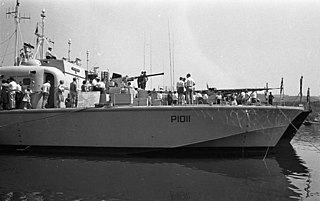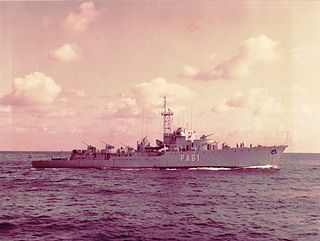
HSwMS Sjölejonet was the lead ship of a class of nine naval submarines in the service of the Swedish Navy from just before World War II into the early Cold War. The submarines were ordered in response to the rising German threat to the south in the interwar period. Sjölejonet remained in service until 1959 and was sold for scrap in 1962.

The Aréthuse class were submarines built for the French Navy in the 1950s. They were designed as attack submarines for anti-submarine warfare and were referred to as Sous-marins de Chasse by the French Navy. These submarines had advanced sensors and were very quiet. They were influenced by the World War II German Type XXIII U-boats. The Daphné class are an enlarged version built for the French, Pakistani, Portuguese, Spanish and South African navies.

The Brave-class fast patrol boats were a class of two gas turbine motor torpedo boats (MTBs) that were the last of their type for the Royal Navy (RN) Coastal Forces division. They formed the basis for a series of simpler boats which were widely built for export.
The Hurja-class motor torpedo boats or H class was an Italian-designed class of Finnish motor torpedo boats, seeing service with the Finnish Navy during World War II. The five boats of the H class were built by Cantieri Baglietto in Genoa, Italy. The ships were converted into patrol boats in 1949, in accordance with the Paris peace treaty and their torpedo armament, forbidden by the treaty, was removed. The H class were stricken from the naval vessel register in 1963.
The Jymy-class motor torpedo boats or J class was an Italian-designed and built class of motor torpedo boats, seeing service during World War II with the Royal Italian Navy and later with the Finnish Navy. The four boats of the J class were built by Cantieri Baglietto in Genoa, Italy and purchased by the Finns on 5 June 1943. Following World War II, the vessels were rearmed according to the Paris Peace Treaty of 1947, losing their torpedo capabilities and given more guns. They were removed from service in 1961.
The Ahven-class minesweepers were a series of six minesweepers of the Finnish Navy. The ships were constructed in 1936–1937 at the Turun Veneveistämö Shipyard in Finland and saw service during World War II. The Ahven class was stricken in 1961.

The Currituck-class seaplane tenders were four ships built for the United States Navy during World War II. The role of a seaplane tender was to provide base facilities for squadrons of seaplanes in a similar way that an aircraft carrier does for its squadrons. While three members of the class were removed from active service in the 1960s, Norton Sound was modified to serve as a testbed for advanced radar and combat management systems, such as the Aegis Combat System.

The Ruotsinsalmi-class minelayers were a two-strong class of minelayers in the Finnish Navy. The two ships, comprising Ruotsinsalmi and Riilahti, were constructed in Finland and saw service in the Winter War and World War II. Riihahti was sunk in an engagement with Soviet motor torpedo boats on 23 August 1943. Ruotsinsalmi survived the wars and remained in service in the post war Finnish Navy until being withdrawn in the 1970s.

BAP Abtao (SS-42) is an Abtao-class submarine of the Peruvian Navy. The vessel which was originally named BAP Tiburón ("Shark"), was constructed by the American Electric Boat company in the United States and launched in 1953. The Abtao class were the last submarines constructed by the United States for the export market. The submarine entered service in 1954 and by presidential decree, was renamed Abtao for the battle during the Chincha Islands War.

The Abtao class were four submarines of the Peruvian Navy that entered service between 1954 and 1957. They are also known as the Lobo class and the Dos de Mayo class and were constructed in the United States to a design based upon the United States Navy's Mackerel class. They were the last submarines to be constructed by the United States for the export market. All four submarines were powered by a diesel-electric system and armed with six 21-inch (533 mm) torpedo tubes. Two of the submarines also mounted a 5 in (127 mm)/25 caliber gun. The four submarines, initially named for animals, were all renamed in 1957 for famous Peruvian battles. Beginning in 1991, the submarines were taken out of service, with the last decommissioned in 1999. One, BAP Abtao, is a museum ship located in Lima, Peru.

The Hamul class were a class of destroyer tenders that were initially constructed as attack cargo ships for the United States Navy during World War II. They operated from 1941 to 1969.

The Bergamini class was a class of four frigates operated by the Italian Navy. They entered service in 1961, with the last one being stricken in 1988.

The Albatros class was a class of eight corvettes designed and built in Italy in the 1950s. Paid for by US funds, they were operated by Italy, Denmark, Indonesia and the Netherlands. The last ships of the class were retired from service in Italy in 1991.

The Ehrensköld class was the first "modern" class of destroyer built by the Swedish Navy after the First World War. It introduced several new features, mainly heavy armament in three 12 cm guns and the new 53 cm torpedo. The class included two vessels, Ehrensköld and Nordenskjöld, which were both launched in 1926 and entered service in 1927. They patrolled the Baltic Sea until 1963, after which they became target vessels. Nordenskjöld was scrapped in 1964 and Ehrensköld in 1974.

The Najaden class, also known as the Huitfeldt class, was a class of two torpedo boats built for and operated by the Royal Danish Navy. Construction started in 1942, with the ships being completed in 1947, and continuing in service until 1966.

NMS Sublocotenent Ghiculescu was a specialized ASW gunboat of the Romanian Navy. Initially built as a French warship in late World War I, she was purchased by Romania in 1920 and fought during World War II, sinking two submarines and one motor torpedo boat. After 1 year of Soviet service, she was returned to Romania and served as a survey vessel until 2002.

The Audaz class was a class of nine destroyers built for the Spanish Navy after the Second World War. Construction was slow, with only four completed to the original design from 1953–1956. The remaining five ships completed as anti-submarine escorts with a new armament and sensor fit from 1960 to 1965, while the original four ships were also modified to this standard. Built at Ferrol, they completed in 1946–1950 and were rated as gunboats, and were redesignated as frigates in 1959. The last of the class, Intrepido, was stricken in 1982.
The Pizzaro class was a class of eight escort vessels built for the Spanish Navy in the 1940s. Built at Ferrol, they were completed in 1946–1950 rated as gunboats, and were redesignated as frigates in 1959. They started to be withdrawn from use in 1968, with the last of the class, Vincente Yañez Pinzon, stricken in 1982.

The Atrevida class was a class of six corvettes built for the Spanish Navy in the 1950s.

The Trad class was a class of nine torpedo boats built for the Royal Thai Navy in the 1930s by the Italian shipbuilder Cantieri Riuniti dell'Adriatico. They entered service between 1935 and 1938. Two of the ships were sunk (and a third badly damaged by French warships at the Battle of Ko Chang in 1941, but the remaining seven ships had long careers, remaining in service until the 1970s.















